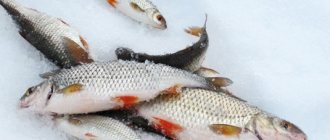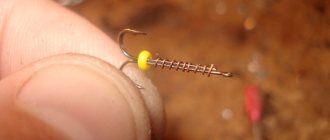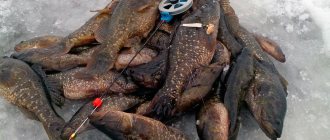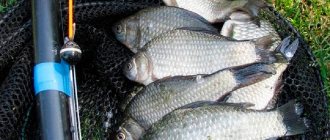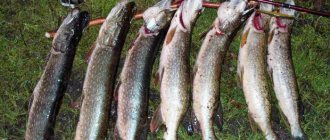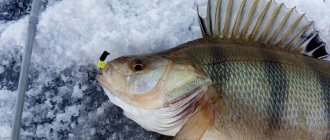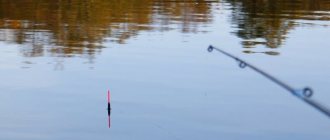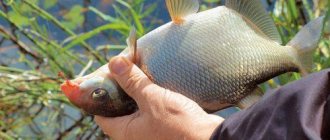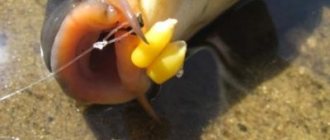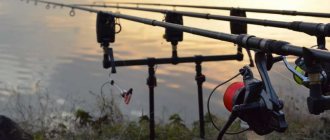Winter float fishing is not so popular in our area. Most people prefer to fish with a jig, some prefer a spoon or a balancer. For some reason, even live bait is caught using jig tackle. And completely in vain! For small fish, which make up the majority of a fisherman's winter catch, a float rod is much more suitable. And a large specimen like bream bites on it more readily than on the same jig. Unfortunately, during Soviet times, traditional Russian winter float tackle was forgotten. Societies of sports fishermen considered it unsportsmanlike, since it involved simply sitting and watching the float, only occasionally playing along with the bait. But recently, a forgotten tradition has been revived.
Meet the winter float tackle
A winter float fishing rod consists of a short winter fishing rod, the length and material of which are not significant. In its simplest form, it is simply a fishing rod, consisting of a whip and a reel handle. You can also use a reel rod, but it must be equipped with a stand, at least in the form of a flyer.
Filly is a fishing rod shape traditional for winter float fishing. Such gear was used back in the century before last and was described by a number of naturalists and researchers, for example, Sabaneev and Aksakov. The advantage of a fishing rod over a fishing rod and reel is that you can measure the amount of fishing line on it in advance without removing the depth on the float, and reel it in at the end of fishing on a reel. Then, when you come to the same place, you don’t need to set the depth; you just need to unwind the fishing rod and immediately start fishing.
It should be noted here that the most convenient are fillies with two reels - one for storing a supply of fishing line, the second for reeling in equipment at the end of fishing. Unfortunately, these are rarely found on sale and fishermen usually make them themselves. There are no special requirements for the material of the whip - the main thing is that it is not too soft and allows hooking. He does not participate in landing the fish - it is pulled out by the fishing line with his hands.
The disadvantage of the filly is that the line on the reel itself can freeze - this is bad when you often move from place to place. However, in winter float fishing you have to do this infrequently; they mostly sit on the same holes. And unwinding frozen fishing line is not too much of a problem - it comes off quite easily, cutting through the ice. By the way, about the fishing line. When winter fishing with a float, it is not at all necessary to use ultra-thin line, which jig anglers often use. If the game is played here, it is usually in the form of a single toss of the nozzle followed by a smooth lowering and will not be hidden by the neutral buoyancy of the fishing line. A fishing line with a thickness of 0.14 and even 0.2 mm would be completely “legal”, although the latter may already alert the fish and will require the use of a leash. However, when catching rotan and some other fish with a float, the thickness of the fishing line does not matter. The author usually uses 0.14, which was purchased with a large supply, both in current and in still water.
The hook is selected according to the type of fish and bait. For example, when fishing for crucian carp, it is better to put a larger hook - a small one simply does not cut through its thick lip. The same applies to rotans. For the latter, it is better to use a large round jig even with a float due to the specific nature of the bite - it usually stands in place for a long time, swallowing the bait, the float moves only at the very beginning of the bite, and then freezes, as a result the fish can swallow the hook deeply, causing it to bite when If you are fishing with two or three rods, you can skip it. And with a jig, the float will float up, and it’s immediately clear what needs to be pulled out.
Sometimes they use a tackle with two hooks. The author believes that historically the same Sabaneev describes a similar equipment when fishing for ruff, however, in modern conditions it is easier to have one more fishing rod than to sculpt more hooks on them. However, when exploring a reservoir, it is possible to use two hooks, when it is necessary to test two different baits; multi-hook tackle can also be used for fishing in the horizons at great depths.
The float and weight are the main elements of the gear. In the classic version, a float is placed, then there is one weight and below it, 10-15 cm, a hook with a nozzle. The load is taken such that it is slightly larger than the carrying capacity of the float, that is, it should sink it. The float in this case is located just below the crust of ice in the hole, it is visible, it does not freeze into the ice. There is no need to overload the tackle, as it will be difficult to see the bites on the rise. The load should only slightly exceed the carrying capacity of the float, taking into account the weight of the hook and nozzle, and the weight of the jig instead of the hook, if one is used.
The winter float must be attached to the fishing line at one lower point. It must have a movable hinge mount or a movable upper part - the fish bite is determined by its movement. This can be seen as the movement of a float under water to the side. If the float is fixed at two points, or a fishing line is passed through its body, then the bite will be difficult to see - its movement up and down is not as noticeable as wagging to the side for an angler looking down.
For the same purpose, the top of the float is often made flat and beveled - it will turn the float during a “crushing” bite. However, even cheap store-bought floats with a round tip are good - they work fine if they are attached only at the bottom point to the fishing line. A beginner should not use floats that are too complex - it is better to start with simple single-body floats, although they come in two or more parts connected by a hinge.
Read: Pike fishing in winter
It should be painted only in light colors - white or yellow. They are best visible on the dark surface of the water in the hole, even in bright light. As a last resort, you can sit with your back to the sun so that the fisherman’s shadow covers the holes and you can clearly see the floats. It should be borne in mind that not only the top, but also the side of the float should be clearly visible. In this case, the top is made a little darker than the sidewall, since when biting the sidewall shows, and this should be noticeable.
Self-production of sideboards
The skill of fishing from a boat is developed by each angler with his own specific methods and secrets, which ultimately adds up to a common treasury of rich fishing experience. And the fact that homemade onboard rods provide the best individual fishing conditions will not be a big discovery.
When making tackle specifically for his needs, the angler will take into account the convenience of the handle to suit his hand, and select the material of the blank and its effective length, which, in his opinion, will most accurately convey the bite signal and guarantee the successful retrieval of the trophy. In fact, it is not so difficult to make side fishing rods with your own hands, and we can say with confidence that a homemade product will be much more budget-friendly than a specialized side fishing rod, no matter from any manufacturer. We will discuss the algorithm for self-assembly of gear, the materials necessary for this and the fishing accessories needed to complete the sideboard in more detail in the subsequent material of the article.
Lever
The handle is one of the most important elements of the gear, which ensures ergonomic use of the product and allows for high-quality and reliable fastening of the reel. In addition, it is this part of the side that should ensure its buoyancy, which is necessary for this type of gear. After all, the likelihood of a sideboard being out of the boat and going to the bottom is much higher than that of fishing equipment that supports fishing sessions from the shore.
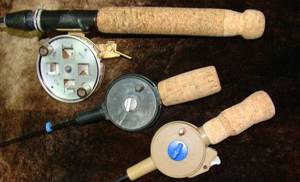
Important! The handle is made from a light and buoyant material, and one of the best and most comfortable materials for tactile sensations is natural cork.
Bottle caps will fit under this element. You just need to drill a hole in them for the entire length of the horizon and place it on a steel wire with a diameter of 3 to 5 mm and glue them together at the ends. The frame made of steel and elastic wire is also a reliable frame for further installation of the reel and rod blank.
Reel mount
Both inertial and non-inertial reels can be used for beading, and in some cases a regular reel will also work as a fishing line storage. Whatever type of accessory the fisherman chooses, it must be securely connected to the rod handle and be harmonious in size and weight with the gear. Inertia reels with a drum size of up to 10 cm in diameter and the smallest inertia-free versions of them are the most suitable candidates to become a component of a fishing rod for fishing from a boat. The small dimensions of the rod allow you to connect the reels and blanks without disassembling them, on a blind one. For this purpose, the method of gluing, riveting, or soldering is suitable if there is a need to connect the metal leg of the reel and the steel frame of the tackle. One of the assembly methods can be connection using insulating tape.
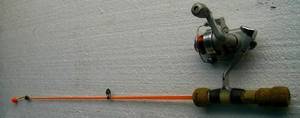
Important! When connecting with electrical tape, you need to take into account that over time, due to exposure to water and sun, this material loses its qualities and, possibly, spontaneous separation of the rod elements.
Whip
The rod of the fishing rod can be picked up from a failed shore fishing rod by connecting the last leg of the Bolognese tackle to the handle of the side. But fishing with side rods is much more sensitive when constructing a whip from a quivertype feeder rod. This part of the equipment can be purchased separately at a fishing store, having selected the required test parameter and system for your fishing conditions. The convenience of this particular method also gives advantages to the existing equipment of the whip with winding rings, which simplifies further assembly of the structure.

In some cases, the rod blank can be taken from a bamboo float rod or a specially selected and dried vine whip. Tackle made from these materials will be coarser than fiberglass or carbon fiber, but it is quite suitable for bottom fishing for large fish.
Rings
For this type of fishing rod, select metal rings of small diameters with ordinary, non-reinforced mounting legs. In working condition, the fishing line does not particularly load the surface of the ring, and the use of expensive rings with ceramic liners is not justified as expensive for beading, and it also adds extra weight to the gear.
Important! The rings are glued to the fishing rod blank using epoxy resin, or they are simply wrapped with insulating tape, followed by heating the material with an open flame, which gives the coils increased adhesion and reduces the effect of water on the insulating tape.
On a form one meter long, it is enough to have three or four winding rings, which will ensure comfortable fishing and will prevent hooks in the boat from the rig supplied to the fishing zones.
Quivertip nod
To determine the bite on some types of edges, a nod is used.
Important! The easiest way to make a signaling device is from lavsan, which is cut into strips of the required length and width from a regular plastic bottle.
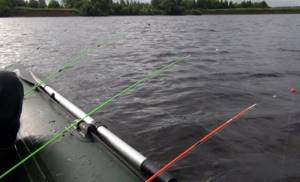
For more convenient visual control of bites, the guard can be made from a colored bottle rather than a transparent one. The transparent nod, and especially its tip, is painted in a noticeable red color using nail polish or a construction felt-tip pen intended for marking on metal. Having a sensitive whip made of graphite or carbon fiber, it is not necessary to fish with a nod. The quiver tip itself shows a good bite due to the high plasticity of the material, which should be used in practice without cluttering the tackle with unnecessary accessories that duplicate the existing guard.
Equipment for fishing on the current
The main feature of float gear is that it can also be used for fishing in currents, even in strong ones. However, it will require special equipment. The fact is that when fishing in the current, the line is dragged down the river. In this case, it can rest against the lower edge of the hole. If this happens, the bite will be very difficult to notice. To prevent this from happening, use an additional small load. It is placed just below the float - the main thing is that it is further than the thickness of the ice. It will hang at the bottom of the hole, creating tension on the fishing line and preventing the small piece of fishing line under the hole from the float to it from going too far forward, and will allow it not to cling to the lower edge of the hole. The rest of the equipment is classic, a weight and then a hook. Of course, when using additional loading, the float must also be larger.
Rigging a fishing rod with a side nod
Nods on fishing rods with jig tackle can be lateral or straight. On long rods, side nods are more visible, which is why they are usually used.
In general, all fishing rods must have their own nods, which can be lavsan, steel or spring.
Side nods
The length of the side nods when summer fishing using jigs is chosen depending on the length of the rod. The longer it is, the longer the side nod it should be equipped with. A correctly chosen nod prevents sudden vibrations and allows you to make smooth and floating play with the jig. For example, if your rod is 6-7 meters long, then the side nod for it should be about 20 cm long.
Telescopic fishing rod with side nod
When checking the correct choice of nod, you need to keep in mind that due to the action of the weight of the jig, the nod is usually in a horizontal position or goes down slightly, while without bait the nod bends slightly upward.
And since the jigs used for fishing can have different weights, then the nods should be chosen to pair with them, also different in length. The option of adjusting the size of the nod during fishing is inconvenient, since this requires more time than the operation of replacing it with another nod. Therefore, when going fishing, it is best to collect many different nods with different lengths.
It is useful to put multi-colored signaling devices on the tips of the nods, made of some light, brightly colored materials, for example, foam or pieces of colored tubes.
Poachers who caught 317 kg of fish were not punished
A group of fishermen revealed the name of the secret bait during interrogation.
Category: regional news.
MORE →
A fishing rod with a side nod is a rather unusual tackle, in which, instead of a float, a “side nod” is attached to the edge of the rod, and a summer jig is used as bait. Fishing with a side nod is quite popular among our anglers, as it allows you to fish in areas densely covered with aquatic vegetation. Even if we take a fly rod, which is also designed for fishing in dense vegetation and hard-to-reach places, there is still a high probability of the float getting caught on obstacles. At the same time, the jig freely reaches the bottom. Another plus is that the nod gives play to the jig, even with a slight swing of the rod.
A fishing rod with a side nod is used to catch roach, bream, carp and crucian carp. If you additionally bait the jig hook with animal bait (bloodworm, caddis larva, maggot), then there is a chance of catching a pike or pike perch; a perch can also bite on a reelless jig.
Equipment for fishing “in the horizons” - a load lying on the bottom
Most often, in winter, fish bite in the bottom layer - this is where most of the food for it is located, and this is where it prefers to stay. However, often schooling fish, bleak, bream or roach, move through the reservoir at different depths. At the same time, she will not refuse food on the hook. Each time changing the depth of the fishing line behind the float is inconvenient and time-consuming; in order to be able to fish at different depths, fishermen came up with multi-hook gear with a weight at the bottom.
The main line is attached to a weight that lies at the bottom. In this case, the float will be more overloaded than in classic gear, and the line will be stretched from the very tip of the fishing rod. From the main line there are several short leashes with hooks from the float to the weight. You can use either a rigid mount or a sliding rig of such a leash, but it is easy to “lose” the depth, since the sliding leash can slide up or down. It is more convenient to have several loops on the main line every half a meter and attach leashes through them as needed. The leashes should be attached to swivels so that the fish does not twist them when pulling them out. Usually they put two or three leashes for different depths.
The fishing rod for such fishing is exclusively “filly”. A line with loops will be difficult to wind onto a reel; the loops will get in the way. But you can reel one of these on a reel without any problems. The float must have a removable mount that will allow the loops to be moved through it. The author uses a fairly thick “leg” with an elastic band that is spacious enough for the loop to pass through it. The body of the float is attached to the leg on a hinge; this float is homemade and quite large. During the fishing process, you can pull out the fishing rod and rearrange the leashes, remove excess ones or add new ones. Long leashes are not needed here - the length of the leash is no more than 15-20 cm. The line for the leash is 0.14, the main line is 0.2.
This gear should be considered quite rough and insensitive, since all this equipment has a large area of contact with the water, provides resistance to fine, delicate bites and is used only when searching for fish in the water column. When fish are found at a certain depth, you should switch to fishing with conventional gear.
Beads and pendants
To make the reel more attractive to fish, you can string several beads on its shank, which are sold in sewing supply stores. Usually use 1, 2 or 3 pieces. Small beads with large holes are best suited for decorating reelless jigs. They should be located on the fore-end freely enough so that when the jig shakes, it makes a knocking noise.
After the beads, you need to put on a cambric so that they do not fall off during fishing. On sale you can also find baits already equipped with beads, jigs with wings, and so on. Such baits with additional “decorations” are best suited for beginners, as it is easier to catch fish with them.
Pendants
You should be wary of reelless reels with pendants. At first glance, it seems that thanks to this additional element the bait will also become more catchy. But in practice, empty bites and nibbles often occur on it, since the fish hits the suspension and does not get hooked. And also small jigs with suspension are very fond of small things like white breams the size of a matchbox.
And here's what you need to know: SALMON FISHING Spinning rod for catching salmon in the Sea Spoons bait for catching Salmon
Fishing technique and tactics
When fishing, much fewer holes will be drilled than when fishing with a jig. Be sure to have a comfortable box for sitting, or even better, a tent. You can fish from a soft mat or sled, but when fishing from your knees, your legs will get tired from kneeling in one place for a long time.
First, the angler drills several holes and checks the depth. In your arsenal you need to have at least five or six fillies with preliminary settings for different depths - so that you do not need to reconfigure them too much and you can only tighten the float a little. It is advisable to sign the fillies by numbers - from the smallest depth to the largest. Then they sit near the hole and wait for a bite. If it’s not there, go to the next one.
A feeder and a depth gauge are the float angler’s best friends. When fishing with a float, you can’t immediately understand whether there will be a bite from this hole; more time is spent than when fishing with a jig. Therefore, initially it is worth taking places at the beginning and end of the dumps, where an interesting bottom, pits on a flat area are determined by tapping. It’s better to drill a couple of dozen holes at the beginning than to start fishing from the first and waste the whole day. Only interesting holes are fed, and not all, and this must be done wisely, without overfeeding the fish, using animal components.
If there is a bite, they stay here and drill a couple more holes, laying out an additional two fillies without numbers, setting them to the appropriate depth initially. At the same time, they look at the float of the first fishing rod: if it bites, we pull it out. An interesting detail: you should not sweep away the crumbs around the hole; it will serve as a natural support for the fishing rod. You need to slam it down a little with a scoop, creating an ice mound of small height.
Read: Winter fishing. Fish bait
This is necessary so that the fish cannot drag the fishing rod into the hole, so that it is initially rested against an obstacle. In the old days, for this they used an ice pick placed in front of the holes, which was used to chop the ice; now they use an ice drill, which is much more convenient. When biting a large fish that has caught itself, a fishing rod being dragged under the water is not that uncommon.
Bait can affect fishing success, but not always. Usually the fish stay in their “winter quarters” and it is quite difficult to lure them to some other place. It is easier to find a good place by drilling additional holes. It is advisable to drill them when searching every ten to fifteen meters, then, when there is a bite, you should drill a few more around the “successful” one, perhaps in some of them there will be a more active bite. There is usually no point in leaving this place.
At first, when there are no bites and the fish have not yet been found, you can sit on one hole for about 10-15 minutes. Then, when the fish is found, the place of more active biting also sits until the end of the day. The fish bite occurs throughout the day with varying success, a school approaches, begins to take, and after the bite there follows a certain lull. You only need to weigh anchor and go searching further if nothing has bitten for a couple of hours. At the same time, it’s worth looking at other fishermen - if they are biting, but here everything is gone, you should go in their direction. Even if they catch perch with spinners, they can just as well catch it with a float with a butterfly, no worse than with a spinner.
Pulling out fish from great depths is done using a “mill” - the fishing line is selected by winding it around your arms spread out to the sides. You should not throw the filly aside at the end - snow sticks to the reel, which makes it difficult to use; quite rarely, it can break through the crust and get stuck; it is better to place it near the hole on a smooth surface. A thicker fishing line for a float tangles much less than an ultra-thin jig. When actively biting with three fishing rods, it is important to quickly be able to pull out, remove, replant and release the fishing line into the hole, then pull out the next one. Often the fish won’t even let you put out the second fishing rod.
Playing along is another element that allows you to catch more. The rod is taken in the hand, then one or two swings are made with a large amplitude - from 30 cm to a meter. At the same time, the nozzle smoothly lowers down, attracting fish. You should not use this technique too often - perhaps the fish has already approached and is sniffing, and then the bait flies up from under its nose when the fisherman decided to play along with it a little more. Everything has its time, you need to have patience when fishing like this.
Trophies
For some reason, a float rod is considered most suitable for bream. However, other types of fish are also willing to take it. Let's start in order with the most common types.
Roach
This fish lives in almost all ponds, lakes and rivers. You can catch it both with animal baits such as bloodworms and maggots, and with plant baits such as semolina and bread. The porridge is not very convenient; you should put it into a syringe for fishing only if this syringe is in a warm pocket and does not freeze. On the contrary, the bread is not afraid of frost and you can fish with it. Bloodworm is a good bait. Maggot is a little worse. Roaches do not bite on worms as readily as on summer days. It is found both at the bottom and in the water column, but it is still more reliable to fish from the bottom. In this case, the hook is placed almost at the bottom, but it should not lie on it - this is important when selecting the weight of the float.
Perch
Yes, yes, perch can be successfully caught using float tackle. Especially in the dead of winter - many fishermen know that playing with a jig at this time is useless, it only scares off the striper, and it is easier to fish with standing tackle. But the float initially involves fishing with a standing bait with virtually no play. An important detail: when fishing for perch, the nozzle is positioned as when fishing for roach near the bottom.
Bloodworms, maggots and worms are used - the last two types only because they are the easiest to store for a long time. In some places they catch it with burdock moth, mormysh crustacean and other aquatic organisms. Well, if it bites, then why not? It is useless to use vegetable baits for perch. Sometimes fry are used as a good bait - in this case you can catch a fairly decent trophy of a kilogram or more.
The problem is that it can be difficult to catch these fry in winter. This is usually how village fishermen catch fish, who catch fry in large ice holes where they rinse clothes or for water with buckets - he comes there to “breathe” and can be caught with a net, colander or even a fishing scoop.
Ruff
Traditionally in Russia this fish was caught only with a float. Sabaneev describes a tackle with two hooks located on a wire crossbar specifically for catching ruff. Now there is not too much of this fish and there are also fewer people who like to catch it specifically. However, sometimes you want ruffs for fish soup, and you can catch them on a float. If you need live bait to catch burbot, you can’t find a better fish than a ruff.
Read: Fishing in winter. Beyond the river
This fish stays on a relatively hard bottom, where there is no silt; it cannot tolerate it. Usually it is pebbles or sand, but sometimes it is found on clay soil. Loves depths of 3 meters and above. On rivers it prefers places with current. It swallows the hook deeply, so it is important not to be late with hooking. Often found as extraneous prey when fishing for bream. Almost never bites in the water column - only from the bottom. In this case, the hook is positioned as when fishing for roach, or a jig is used - it should slightly overload the float, the bite will be visible on the rise.
Rotan
Recently, rotan has become a common catch for fishermen. It is tasty, found in places where other fish simply cannot survive. So you can catch it even in the evening in the city pond near your house. The best bait for rotan is another rotan. He reacts sharply to the smell of his relatives; it is in his nature, apparently, to eat up the leftovers and eat damaged fish of his tribe.
It willingly eats its own fry - they look like tadpoles, only much larger. You can use a worm as bait - it is quite attractive and stores well. If not available, take bloodworms, maggots, or any animal bait that will move on the hook. A rotan will not take on a worm or maggot hanging motionless.
After catching the first one, you should cut it with a knife and use its insides as a bait. This is the best bait, rotan smells it from afar and will willingly come to feast on its fellow fish. Sometimes you should play along with the nozzle so that the smell in the water spreads further. Rotan bites not on the game, but on the smell - this should be remembered. Therefore, it is more correct to catch it with a float than with a spoon or jig with a game. Instead of a hook, use a large jig, described earlier. The hook itself should be large. The nozzle is placed in the water column near the bottom; usually it is located in the thickness of the bottom hornwort not at the bottom, but above it.
The layer of hornwort also has its own specifics - in the upper part there are long vertical stems, and at the bottom a continuous matted carpet is formed. You should try to fish 20-30 cm above its border. You can easily determine it using an empty feeder. Usually, when lowered onto the carpet, this is felt; the feeder smoothly stops its movement. In this case, the depth gauge will simply penetrate it to the bottom.
Bream
Most anglers prefer to catch it with a float. Indeed, most of the bream caught from the hole in winter went to floaters. A bream is more likely to take a stationary bait than a jig during a game - it often scares it away rather than attracting it. It is caught at great depths from the bottom, sometimes it bites in the water column, but less often. It prefers the so-called bream pits, where it accumulates in large quantities in winter. In former times, it was a massive prey there for baggage poachers, but now this method of fishing is prohibited.
The bait is used both animal and vegetable. It is difficult to guess its preferences in advance, so they are caught with several fishing rods using different baits. Somewhere it bites on pasta, somewhere on maggots and bloodworms, somewhere it grabs pearl barley. The bait is of great importance. If you feed bream in a deep-sea place for a long time, it will constantly stay there in large quantities. Some fishermen make holes for themselves and work on them in shifts, constantly feeding the fish and replacing each other in the tent, if possible. It prefers fairly hard clay soil, rarely stands on silt or in grass and is only passing through. The equipment is used with a small pad, which slightly overloads the float. In this case, the hook itself with the nozzle lies on the bottom, the bait too, and the sinkers are located in the water column. The bite is visible on the rise.
crucian carp
In some reservoirs it is readily caught from the ice. They say that in Siberia there are entire lakes inhabited only by crucian carp, where they catch more of them from the ice than in the summer. And in the summer he is inactive there. However, in the European part of Russia this does not always happen - there are places where he refuses to take under the ice and only bites when it disappears. One of the few fish that, even in winter, prefers to stay on muddy ground, among reeds and other similar places - the rest leave there, since there is little oxygen there, which is wasted by rotting plants. This doesn’t bother Kara at all.
Quite picky. Can be caught on different baits. You need to have several of them, and if it stops pecking in some place, the first thing you need to do is change the nozzle. Subject to attachment - often stays at feeding places for several years and takes only there, even if the supply of porridge and food has long ceased. In winter it bites from the bottom; it is extremely rarely caught in the water column. A fishing rod is equipped as for catching bream or, if the bottom is overgrown, as when fishing for roach, with a hook “hanging” in the thickness of the algae. It requires a large hook to cut through a thick lip. A crucian carp on a hook behaves very smartly and you need to make a lot of effort to get it - it’s nice. It has a sharp, large spike in its caudal fin, which can cause injury when removing the fish from the hook.
Subscribe to
our channel in Yandex Zen
